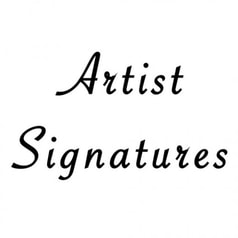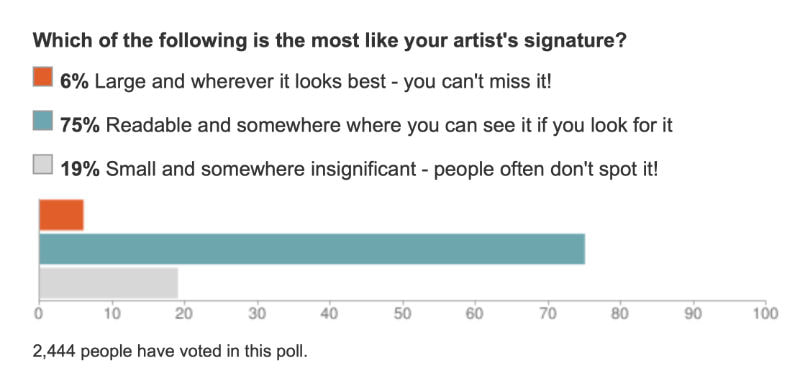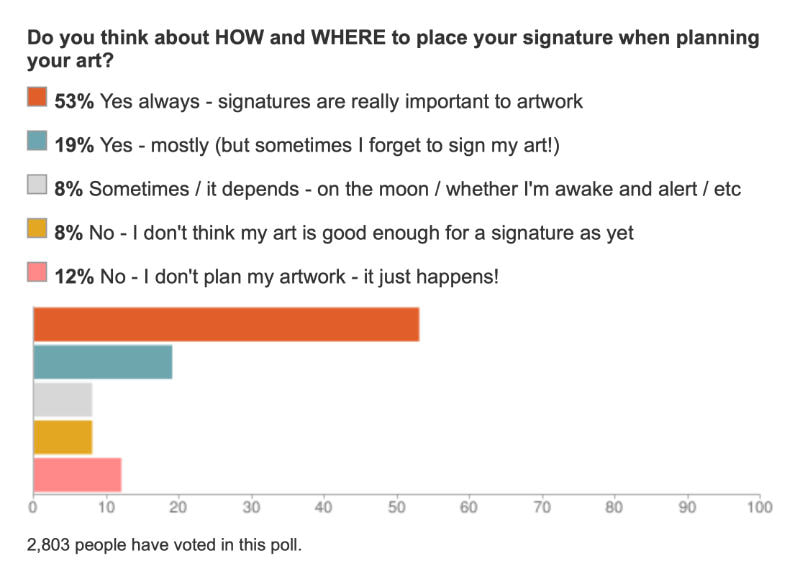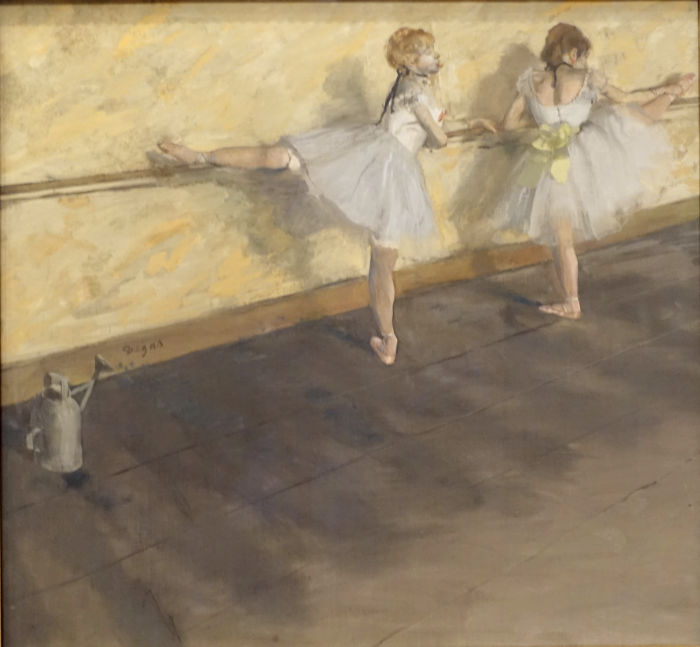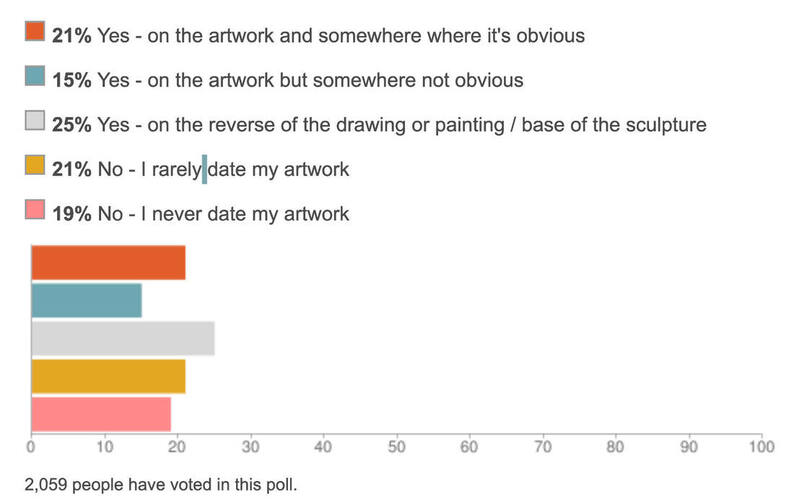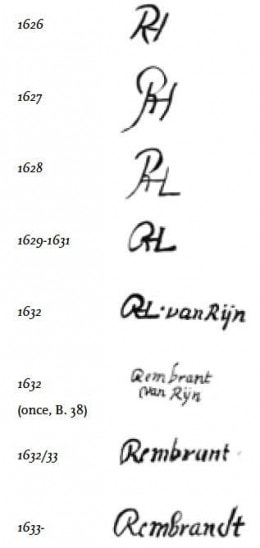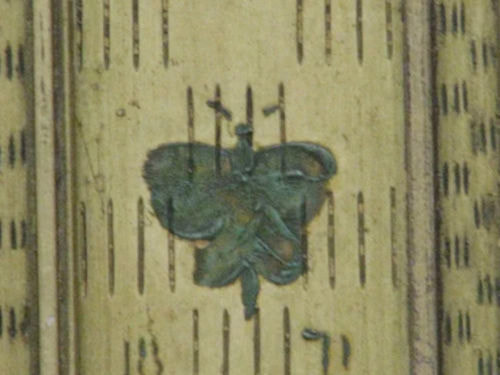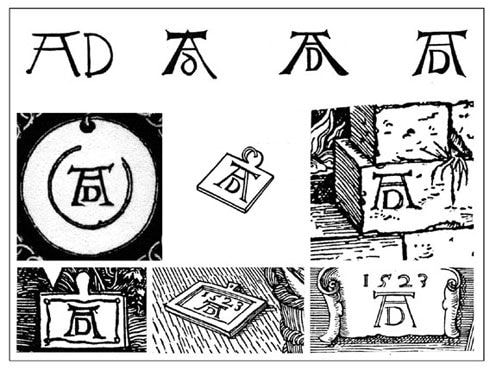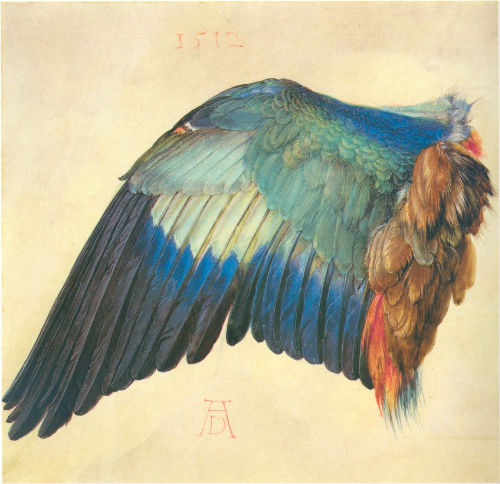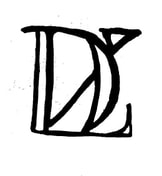- Home
- NEWS
-
PRACTICE
-
MARKETING
- How to write an Artist's Statement >
- How to write an Artist's Resume or CV >
- How to sign a painting, drawing or fine art print
- Business Cards for Artists
- How to write a press release for an artist
- The Private View Invitation
- Publicity for Juried Exhibitions
- Websites for Artists >
- Image & Video sizes for Social Media Sites
- How to be mobile-friendly
-
SELL ART
- FRAME ART
-
SHIP ART
-
COPYRIGHT
-
MONEY & TAX
- About + Help
- BANKING
Answers to common artists' questions e.g.
What's the best way for an artist to sign a painting?
Should you date as well as sign a painting?
How should you sign a fine art print?
What's the best way for an artist to sign a painting?
Should you date as well as sign a painting?
How should you sign a fine art print?
|
These are just some of the questions about signatures asked by artists and art lovers - and below you can find a lot of the answers!
This section offers a structured introduction to artists signatures for ARTISTS who want
|
|
BELOW you can find out about:
|
FIRST review:
FINALLY - for ART LOVERS AND COLLECTORS who want to know more the signatures of artists from the past and present
|
WHY SIGN YOUR ART?
How do YOU sign your art?
Try the four polls - which quiz you about YOUR artistic Practice - BEFORE before you start reading this page about signing art and artist's signatures.
The charts BELOW demonstrate the results from the polls about signatures that I ran on my previous website for some years. I now run the polls on Crowd Signal.
You can check more recent results by clicking 'view results' under each poll.
The charts BELOW demonstrate the results from the polls about signatures that I ran on my previous website for some years. I now run the polls on Crowd Signal.
You can check more recent results by clicking 'view results' under each poll.
How to sign art - the artists' perspective
What follows are the views of other artists - expressed via a number of polls I ran on another website.
The charts cover:
The charts cover:
- size and location of the signature
- whether you plan your signature in advance
- whether or not to date your artwork
SIZE & LOCATION OF THE ARTIST'S SIGNATURE: Which of the following is the most like YOUR artist's signature?
There's a very clear favourite when it comes to signing art. Not too obvious and not too difficult to find and very definitely readable is the preferred option of 75% of artists. By way of contrast:
- just 6% prefer a more flamboyant 'in your face' style
- 19% would really prefer it if the signature was not something which jumped out at you and if nobody spots it, so much the better.
Your mark should identify you as the artist, compliment the painting and not distract from the work.
Róisín O'Farrell - Signing Your Work
PLANNING YOUR SIGNATURE: Do you think about WHERE to place your signature when planning your art?
Planning signatures tends to become something you do over time as you create more and more painting - and begin to wish you'd thought rather more about where the signature was going at an earlier stage.
- Over half ALWAYS plan where they will place the signature
- 72% almost always sign and think about this before signing
- 20% do not sign their art - either because they don't yet consider it good enough or because they never plan a signature before they start - and then decide
DATING ARTWORK: Do you include a date on your artwork?
|
There's a variety of views - and practices - about dating artwork.
|
It's worth noting that:
|
|
Constraints on dates
Serious artists have told me that galleries are very against having paintings dated on the front as it can sometime be off-putting to buyers who for some reason think a painting painted five years ago is less good than one painted yesterday! However, it's very odd that art collectors don't have a problem buying art which is 105 years old as opposed to 100 years old! |
My Practice
I always sign and date my artwork on paper with my real signature and the date of the artwork - but I then cover that with mat and frame and initial the work on the part that shows. Plus I keep folders of paper and digital files relating to each artwork - as do very many artists. Bottom line - signing the work is extremely important - but dating it in a visible way is not, if you are keeping other records of how and when you work was made. |
Pros and Cons of signing your Art
Why should you sign your art?
What are the benefits for you - and for those buying your art or inheriting it in the future?
What are the benefits for you - and for those buying your art or inheriting it in the future?
|
PROS
|
CONS
|
|
TIPS RE. WHETHER OR NOT TO SIGN YOUR ART
|
REFERENCE:
- 7 important things to know about artist signatures | Christies - Holly Black consults Christie’s specialists, a conservator, a gallerist and an expert cataloguer on the truths an artist’s mark can reveal and the insights they offer into process
- Signatures, Monograms, and Markings - Researching Your Art | Smithsonian Museum
- 3 Reasons to Sign your Artwork and 2 Reasons Why I Choose Not To | Empty Easel
- Signing your work | Jackson's Art - reader's comments on how they like to sign their art
Initials, surname - or change your name?
|
The question of which name to use and how to sign it is a more common one than you might think.
Here are some tips:
|
REFERENCE
|
Monograms, Initialed Signatures & Motifs
|
Monograms have a long history when it comes to signing paintings. They can be:
|
Whistler chose to adopt the butterfly motif (a popular image in Oriental art), as a signature in the 1860s. Over the years his butterfly signature evolved and he began to place it in his paintings as a deliberate compositional element, as well as a monogram from 1873.
James McNeill Whistler's Butterfly Signature | Joseph Scissorhands
|
How to create a Monogram
A monogram is a motif which indicates a work was created by a particular person. A monogram is normally made of letters or graphemes (a grapheme is "the smallest semantically distinguishing unit in a written language". The process used for creating a monogram for use in published documents is also one which can be used when trying out different ways you can create a monogram from a selection of all or one initials in your artist's name. |
REFERENCE:
|
HOW TO SIGN......
TIPS: How to sign your art
|
TIPS include making a decision about:
|
MUST DO" TIPS
Your signature should NOT be the first thing that jumps out at you when you view a work of art. It should never compete with the painting and never be the focal point. A monogram is a motif made by overlapping or combining two or more letters or other graphemes to form one symbol. Monograms are often made by combining the initials of an individual or a company, used as recognizable symbols or logos. A series of uncombined initials is properly referred to as a cypher and is not a monogram, although ciphers are frequently referred to as monograms. |
REFERENCE:
Below you will find links to articles discussing the importance of a signature and provide some tips on how to do it
Below you will find links to articles discussing the importance of a signature and provide some tips on how to do it
- Creating a signature on your art | Making A Mark - One of the perennial issues which comes up time and time again concerns the best way to sign your art. Here's a checklist of things to think about before you sign:
- Signing Your Art, Sign Clearly, Signature Tips | artbusiness.com - Signing your art is an integral part of the creative process. The instant you apply your name to a piece of your art, you declare that art officially finished and ready for public exposure. No matter what your signature looks like, what form it takes
- How to Sign a Painting | painting.about.com - Find out where, how and why you should add your signature to a painting when you've finished it.
- Robert Genn - Painter's Keys | Signing and dating - I'm a member of a party who thinks signatures should be clear, consistent and pretty well always in the same place--lower right.
- Have a Great Artist Signature and What Your Signature Communicates - A great artist signature should be Legible, Proportionate to the art, Appropriately placed on the art, and Consistent.
- How to Sign a Painting, Drawing or Artwork - My Top Ten Tips | Your Art Practice | Creativity Pro - Learn how to sign your painting, drawing or other artwork with tips which will transform your signature from ho-hum to oh wow!
- How to sign your art so people can actually read it
- On signing your art | Liz Haywood-Sullivan Fine Art - some sound tips for signing your art
- More on Signing Your Artwork | Liz Haywood-Sullivan Fine Art - This may seem simple but be sure to sign your artwork - redundantly. Sign your painting on both the front, AND the back
How to sign an oil painting
|
Techniques for signing an oil painting vary. Normally there's a formal signature: people sign bottom left or bottom right - but this is not always the case - using oil paint used in the painting. Plus an informal signature - on the back of the board or stretchers where the artist might use another medium e.g. a sharpie to make clear who produced the artwork
You should ALWAYS practice first! Until you have developed a skill in signing a painting in oil paint. You can:
|
REFERENCE:
|
How to sign a diptych or triptych
|
If you only sign one panel of a diptych or triptych what happens if the painting gets split up either accidentally or on purpose?
|
Signal this is a DIPTYCH (or a work of parts)
One other useful way of indicating that a painting is a diptych or triptych (or some larger number e.g. 50 - you too could become another David Hockney one day!!) is to
|
You could choose to only sign one panel on the front of the painting with your signature - to indicate this piece of art is one piece as opposed to two or three. However if you take the view that the signature indicates provenance there's nothing wrong with signing all the panels on the reverse to make absolutely sure it's clear who created the work.
This is what Robert Genn had to say on the matter
This is what Robert Genn had to say on the matter
I believe in signing every unit. To avoid the goofy repetition look, understate the signatures or hide them in some obscure place, foliage, etc. Nothing worse than an orphan tych of a diptych or a triptych that wanders the world unknown.
Rovert Genn
How to sign a watercolour painting
|
Always sign a watercolour painting in watercolour.
As always plan where you're going to sign it from the beginning. Your approach may vary depending on whether you are signing paper (e.g. as a botanical or natural history artist) or signing over paint (e.g. as watercolour artist of generic subjects) You can:
|
REFERENCE: How to sign a watercolour painting
|
|
|
|
How to sign a mixed media / acrylic painting
|
Some suggestions for how to sign mixed media paintings - and note that some of the suggestions contradict one another e.g. re. the use of a marker pen. Note however that marker pens are not always lightfast - and the signature may fade.
Acrylic painters need to use more water to create a more fluid paint before attempting a signature. As with oil painters, the use of a brush designed for lettering helps with a signature. |
REFERENCE:
|
How to sign pastel artwork
|
Signing a pastel drawing - where you've not covered all the paper is easy enough - however it's not easy to sign a pastel painting where the whole of the support is covered.
In addition some surfaces work better than others if you want to include your signature as opposed to a monogram. Things you need to think about which are specific to pastels
Don't experiment on a finished work! |
FOUR WAYS of signing a pastel painting
The general recommendation is always to sign with the medium you are using however below are four alternatives:
REFERENCE:
|
How to sign a drawing
This is a checklist of things to think about BEFORE signing a drawing:
|
|
How to sign a fine art print - tips and techniques for printmakers
|
The convention which maintains the distinction between hand-pulled fine art prints and prints which are mechanical reproductions is that
|
An artist's name on a print can increase the price by two or more times, and creators generally view signing and numbering works as a valuable source of income for themselves. |
|
TIPS for signing fine art limited edition prints
|
"DO NOT"
|
REFERENCE:
- How to sign an art print | MAKING A MARK - The Do's and Don'ts of Signatures for Printmakers Here's a summary of the conventions - and a few tips about what NOT to do
- Printmaking 101 Series: A Guide to Editioning and Signing Fine Art Prints | PrintGozalez - This is the first in a series of skill share posts that I will call the Printmaking 101 Series. I will be sharing the accumulated knowledge of over 15 years of printmaking through these posts.
- Prints and Printmaking - some basic Terms and Protocols [PDF] | InkMasters Cairns - a compilation of processes, protocols and a glossary of terms for those new to printmaking which you can download for free. It includes how to sign a print as well as what makes an edition.
- Daniel Grant: What's the Value of a Signature on an Art Print? | Huffington Post - Several years before his death in 1987, Andy Warhol sat down and signed his name on copies of the tabloid magazine Interview, of which he was the editor. Regularly costing $2, he charged buyers $50 for these signed copies and they sold pretty fast.
- How to Sign Art Prints | eHow.com - Artists should take the important final step of signing their prints. Signing your print ensures that people will know that you made it and considered it finished. Signed prints also tend to be more valuable. Artists tradition
- Epic Edits | Archive | Making Fine Art Prints: Signing - I’ve had a few people ask the same questions about where to sign, how to sign, what to sign with, etc. If there existed an official rule book, set of laws, or holy parchment that contained the answers I’d direct everybody to the web page.
How to sign a copy of another artwork
The basic principle of signing your artwork is to indicate that you produced it.
However if you have copied a painting, it's NOT your painting!
However if you have copied a painting, it's NOT your painting!
- It's called a derivative work.
- If you represented it as all your own work then you'd be committing fraud.
|
.So how should you sign it?
NEVER, under any circumstances, attempt to forge the signature of artist on an artwork you've produced - whether or not it is a copy. Otherwise you could find yourself in Court or worse! |
REFERENCE
|
Signature Membership (of an Art Society)
This is MY definition of signature membership
"Signature membership (for artists) means all those people who have qualified to use a set of letters after their surname and be known as a full member of an art society. The process of becoming a signature member is almost always defined by a set of criteria which varies from art society to art society. It usually means you are also a fully paid up member in good standing as well."
Practice varies considerably as to whether or not people use the signature membership initials in their signature on an artwork. It's more usual to see them displayed against an artist's name in catalogues of an exhibition.
However not everybody seeks letters after their name. Take a look at Robert Genn's perspective (below) on credentials
- Those important letters | Robert Genn - Painter's Keys - I'm told that in some jurisdictions credentials are important, but I'm not sure where those jurisdictions are. Further, I've never heard of someone coming into an art gallery and saying "Do you have anything by an RA?"
|
MARKETING
Marketing the Artist
|
|
ABOUT ART BUSINESS INFO. FOR ARTISTS
This website aims to provide a compendium of resources about the art business for artists. Please read "PLEASE NOTE"
It helps artists learn how to do better at being business-like, marketing and selling their art and looking after their financial security.
This website aims to provide a compendium of resources about the art business for artists. Please read "PLEASE NOTE"
It helps artists learn how to do better at being business-like, marketing and selling their art and looking after their financial security.
|
Copyright: 2015-2021 Katherine Tyrrell | Making A Mark Publications
- all rights reserved If you've got any suggestions for what you'd like to see on this website please send me your suggestion
|
PLEASE NOTE:
1) Content and the law change all the time. It's impossible to keep up with it if you're not working on the topic full time. 2) I research topics carefully. However, I am totally unable to warrant that ANY and/or ALL information is
|
3) Hence all information I provide comes without any LIABILITY whatsoever to you for any choices you make.
4) This website is FREE FOR YOU but not for me. Links to books are Amazon Affiliate links. Buying a book via this website means I get a very small payment which helps to fund and maintain this website. .I much appreciate any support your provide. Adverts are provided by Google AdSense - but the adverts do not mean I endorse the advertiser. |
- Home
- NEWS
-
PRACTICE
-
MARKETING
- How to write an Artist's Statement >
- How to write an Artist's Resume or CV >
- How to sign a painting, drawing or fine art print
- Business Cards for Artists
- How to write a press release for an artist
- The Private View Invitation
- Publicity for Juried Exhibitions
- Websites for Artists >
- Image & Video sizes for Social Media Sites
- How to be mobile-friendly
-
SELL ART
- FRAME ART
-
SHIP ART
-
COPYRIGHT
-
MONEY & TAX
- About + Help
- BANKING
